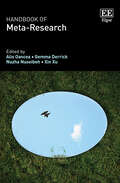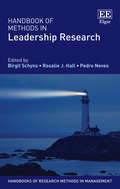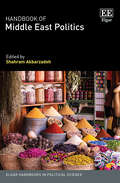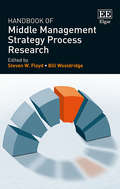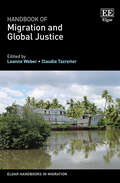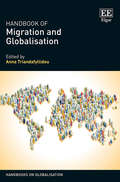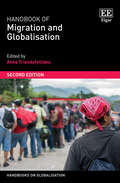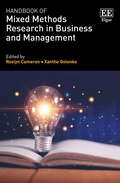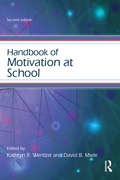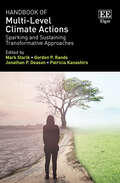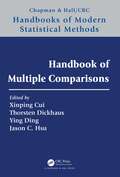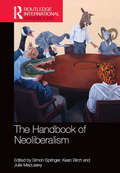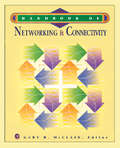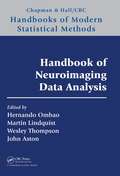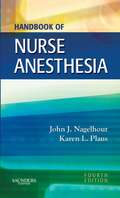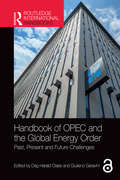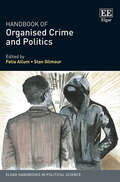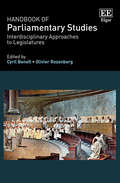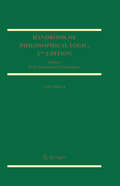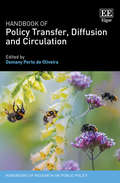- Table View
- List View
Handbook of Meta-Research
A collective project arising from a dynamic configuration of research concerned with systematic, critical and reflexive inquiry into the normative frames, institutional workings and lived realities of research, this dexterously-crafted Handbook acts as a working guide to the rapidly-evolving interdisciplinary field of meta-research.Bringing together cutting-edge multidisciplinary scholarship, the Handbook expertly outlines key domains including the public value, policy and governance of research, knowledge dynamics, and research cultures and careers. Engaging with diverse philosophical, theoretical and methodological approaches, it examines global dynamics in research and explores equality, diversity and inclusion across sectors, career stages and geographical regions. Taking on board multi-layered perspectives from beyond traditional and exclusionary epistemic boundaries, the Handbook offers unique insight into this broad landscape of knowledge.The Handbook of Meta-Research will appeal to researchers and students in a broad range of fields from the social sciences, arts and humanities and STEM who are concerned with the environments, institutions, policies, practices and evaluations that impact their work, and will be a useful starting point for researchers wanting to initiate meta-research studies to examine their own environments, actions and behaviours. Regulators, users and beneficiaries of research will similarly benefit from this authoritative reference work.
Handbook of Methods in Leadership Research (Handbooks of Research Methods in Management series)
by Birgit Schyns Rosalie J. Hall Pedro NevesThis Handbook brings together experts in the field of leadership to provide insights into methods for leadership research. It serves to motivate them to use new research methods to further our knowledge of the leadership field. Illustrating novel approaches to research with sample questions and applications to the field of leadership, this comprehensive and accessible Handbook covers key methodologies in leadership research today, as well as introducing methods that will be invaluable in the future. With chapters written by established leadership scholars, the Handbook of Methods in Leadership Research is arranged to cover three core areas of research: measurement and design, quantitative analytic approaches, and qualitative analytic approaches. The book provides an accessible overview and starting point to discover new methods. All chapters are well researched and provide references for those who want to delve deeper into the topics covered. The volume ends with a summary of tips for each method presented. This book will be an indispensable resource for leadership students, scholars, and practitioners alike, to inspire their future research but also to support their understanding of the quality of research carried out by others.
Handbook of Middle East Politics (Elgar Handbooks in Political Science)
This Handbook uses a comprehensive study of political institutions, social movements and external pressures to offer nuanced study of politics in the Middle East. Foremost scholars on the Middle East examine key themes such as political change, regional rivalry and authoritarianism, making this collection very timely and relevant as an authoritative source.Throughout history, the Middle East has been subject to high levels of political upheaval, revolutions, interstate and intrastate conflict and population dislocation. Charting the ongoing disruptions to authoritarianism in the Middle East, chapters consider the internal logic of the divide between state and society, the continued disregard for societal needs, and the suppression of legitimate grievances, all of which would indicate further and future upheavals. The Handbook engages with questions of political legitimacy and popular aspirations, energy and environmental security, foreign power interests and political ideologies to present a well-rounded picture of a dynamic region.Readers will find this book rich in original and measured insights. Incorporating development studies, politics and public policy and political geography, this Handbook provides scholars and students with compelling insights into Middle Eastern politics.
Handbook of Middle Management Strategy Process Research (Research Handbooks in Business and Management series)
by Steven W. Floyd Bill WooldridgeWith contributions from some of the field’s most influential scholars, this Handbook provides a path forward for students and researchers interested in strategy process research from a middle management perspective. This groundbreaking Handbook both reviews existing theory and explores new ground concerning key issues surrounding middle managers’ influence on strategy making. Split into five distinct sections, the book explicates the unit of analysis and presents foundational theories, emerging models, cutting-edge methods, and original empirical research in strategy process research. Contributors with diverse theoretical and methodological perspectives identify and address a wide range of research issues relevant to middle managers’ participation in strategy making, such as social network analysis and video methodology. Standout chapters include one on complex strategic integration by Robert A. Burgelman and one on the development of theory by Henry Mintzberg. This Handbook is a must-read for academics interested in strategy process research as it suggests novel research approaches for addressing relevant phenomena and provides an up-to-date review of the extant literature in the area.
Handbook of Migration and Global Justice (Elgar Handbooks in Migration)
This timely Handbook brings together leading international scholars from a range of disciplinary backgrounds and geopolitical perspectives to interrogate the intersections between migration and global justice. It explores how cross-border mobility and migration have been affected by rapid economic, cultural and technological globalisation, addressing the pressing questions of global justice that arise as governments respond to unprecedented levels of global migration. Chapters analyse the key issues arising from tensions between international and national priorities, duties and laws, as well as visions for human coexistence and harmony. Featuring chapters written by researchers, political activists and contributors with lived experience of migration injustice, the Handbook explores central topics including failures in refugee protection, worker exploitation and violence against migrants. Looking ahead, it also discusses possible pathways to achieve global justice in and through migration, in terms of geopolitics, subjective experience, human rights and redistributive justice, global solidarity and political activism. Combining empirical case studies with cutting-edge theory, this Handbook will be an invaluable resource for scholars and students of migration, human rights and public policy. The application of the global justice concept to issues of migration and border control will also be useful for policy makers, practitioners and NGOs in these areas.
Handbook of Migration and Globalisation (Handbooks on Globalisation series)
by Anna TriandafyllidouThis Handbook explores the multifaceted linkages between two of the most important socioeconomic phenomena of our time: globalisation and migration. Both are on the rise, increasing in size and scope worldwide, and this Handbook offers the necessary background knowledge and tools to understand how population flows shape, and are shaped by, economic and cultural globalisation. Through central themes which correspond to the four domains of human life – politics, economics (separated into trade and development, and the global division of labour), culture and family life – expert authors from five continents highlight the interdependence between migration and globalisation, and explore the mutual impact of economic, social and political globalisation on international population flows. They also investigate how migrants themselves become agents of the globalisation process. With accessible language that guides the reader easily through complex issues, this Handbook makes an ideal resource for undergraduate and graduate students, researchers and academics interested in migration, ethnicity, development, international relations and international economics.
Handbook of Migration and Globalisation: Second Edition (Handbooks on Globalisation series)
This thoroughly revised and updated Handbook brings together an international range of contributors to highlight the deep interdependence between migration and globalisation and explore the impact of economic, social and political globalisation on international population flows. It provides an interdisciplinary perspective on a discussion that has been intensifying and diversifying over the past 25 years.Chapters provide an overview of important research questions, relevant literature, main approaches and findings in the field, and set out future challenges facing the international community. Particular focus is paid to the global economy, dynamics of interregional and internal migration, links between global migration and climate change and the cultural ramifications of migration. In this revised second edition chapters consider the interlinking issues of migration and health, climate change and human mobility, and the use of digital technologies in the governance of migration and asylum systems.Exploring the multifaceted linkages between two of the most important socio-economic phenomena of our time, this Handbook will prove an ideal resource for researchers and journalists focused on international relations and migration. It will also be useful for scholars and students of social and public policy, sociology, political science, geography, migration development and legal theory.
Handbook of Mixed Methods Research in Business and Management
This timely Handbook illustrates a myriad of theoretical and practical applications in the utility of mixed methods research (MMR) in business and management. It surveys innovations in MMR to provide a full overview of the past, current, and future complexities of the field. With 26 chapters authored by leading international researchers, this fascinating Handbook provides a rich overview of methodological insights into business-applied MMR. It details foundationally important data integration techniques, quality criteria in MMR, and innovative analytical techniques such as qualitative comparative analysis and multilevel MMR. By investigating the effect of rapid developments of new technology such as AI, it focuses on the future of the field, making this Handbook indispensable for maintaining the practice of business and management research for future scholarly generations. The Handbook of Mixed Methods Research in Business and Management will be a crucial read for academics and students researching areas within business and management, human resource management, and economics. Additionally, its examination of case study examples of problems and phenomena in business and management will be useful for those in industry and policy formulation.
Handbook of Motivation at School (Educational Psychology Handbook)
by Edited by Kathryn R. Wentzel and David B. MieleThe second edition of the Handbook of Motivation at School presents an integrated compilation of theory and research in the field. With chapters by leading experts, this book covers the major theoretical perspectives in the field as well as their application to instruction, learning, and social adjustment at school. Section I focuses on theoretical perspectives and major constructs, Section II on contextual and social influences on motivation, and Section III on new directions in the field. This new edition will have the same popular organizational structure with theories at the beginning. It will also include new chapters that cover motivation as it relates to identity, culture, test anxiety, mindfulness, neuroscience, parenting, metacognition, and regulatory focus.
Handbook of Motivation at School (Educational Psychology Handbook)
by Kathryn R. Wentzel David B. MieleThe second edition of the Handbook of Motivation at School presents an integrated compilation of theory and research in the field. With chapters by leading experts, this book covers the major theoretical perspectives in the field as well as their application to instruction, learning, and social adjustment at school. Section I focuses on theoretical perspectives and major constructs, Section II on contextual and social influences on motivation, and Section III on new directions in the field. This new edition will have the same popular organizational structure with theories at the beginning. It will also include new chapters that cover motivation as it relates to identity, culture, test anxiety, mindfulness, neuroscience, parenting, metacognition, and regulatory focus.
Handbook of Multi-Level Climate Actions: Sparking and Sustaining Transformative Approaches (Research Handbooks in Business and Management series)
The Handbook of Multi-Level Climate Actions emphasizes the need for significant climate action by every capable person on the planet at multiple levels of human experience and society. This includes individuals/households, formal and informal groups, organizations/communities, from local to global, and all levels of businesses, governments, and nonprofit organizations. It highlights the many ways that our species can meet the climate crisis and how entities at every level of human experience are, could be, and should be developing and implementing climate solutions, including those advancing energy efficiency, renewable energy utilization, and nature’s ability to sequester carbon.Nearly two dozen knowledgeable, caring, and active authors, representing both academics and practitioners, from multiple countries and disciplines, have risen to the challenge of attempting to motivate as many people as possible to take whatever actions they can as urgently as possible, to ensure that future generations of both humans and non-humans on this planet will have a sustainable climate that meets their on-going needs.This Handbook is an important work for scholars and practitioners working in the realm of environmental and climate issues, sustainability and CSR. It provides a comprehensive exploration of the current global situation, while also inspiring immediate action and forward thinking.
Handbook of Multiple Comparisons (Chapman & Hall/CRC Handbooks of Modern Statistical Methods)
by Xinping Cui Thorsten Dickhaus Ying Ding Jason C. HsuWritten by experts that include originators of some key ideas, chapters in the Handbook of Multiple Testing cover multiple comparison problems big and small, with guidance toward error rate control and insights on how principles developed earlier can be applied to current and emerging problems. Some highlights of the coverages are as follows. Error rate control is useful for controlling the incorrect decision rate. Chapter 1 introduces Tukey's original multiple comparison error rates and point to how they have been applied and adapted to modern multiple comparison problems as discussed in the later chapters. Principles endure. While the closed testing principle is more familiar, Chapter 4 shows the partitioning principle can derive confidence sets for multiple tests, which may become important as the profession goes beyond making decisions based on p-values. Multiple comparisons of treatment efficacy often involve multiple doses and endpoints. Chapter 12 on multiple endpoints explains how different choices of endpoint types lead to different multiplicity adjustment strategies, while Chapter 11 on the MCP-Mod approach is particularly useful for dose-finding. To assess efficacy in clinical trials with multiple doses and multiple endpoints, the reader can see the traditional approach in Chapter 2, the Graphical approach in Chapter 5, and the multivariate approach in Chapter 3. Personalized/precision medicine based on targeted therapies, already a reality, naturally leads to analysis of efficacy in subgroups. Chapter 13 draws attention to subtle logical issues in inferences on subgroups and their mixtures, with a principled solution that resolves these issues. This chapter has implication toward meeting the ICHE9R1 Estimands requirement. Besides the mere multiple testing methodology itself, the handbook also covers related topics like the statistical task of model selection in Chapter 7 or the estimation of the proportion of true null hypotheses (or, in other words, the signal prevalence) in Chapter 8. It also contains decision-theoretic considerations regarding the admissibility of multiple tests in Chapter 6. The issue of selected inference is addressed in Chapter 9. Comparison of responses can involve millions of voxels in medical imaging or SNPs in genome-wide association studies (GWAS). Chapter 14 and Chapter 15 provide state of the art methods for large scale simultaneous inference in these settings.
Handbook of Multiple Comparisons (Chapman & Hall/CRC Handbooks of Modern Statistical Methods)
by Xinping Cui, Thorsten Dickhaus, Ying Ding, Jason C. HsuWritten by experts that include originators of some key ideas, chapters in the Handbook of Multiple Testing cover multiple comparison problems big and small, with guidance toward error rate control and insights on how principles developed earlier can be applied to current and emerging problems. Some highlights of the coverages are as follows. Error rate control is useful for controlling the incorrect decision rate. Chapter 1 introduces Tukey's original multiple comparison error rates and point to how they have been applied and adapted to modern multiple comparison problems as discussed in the later chapters. Principles endure. While the closed testing principle is more familiar, Chapter 4 shows the partitioning principle can derive confidence sets for multiple tests, which may become important as the profession goes beyond making decisions based on p-values. Multiple comparisons of treatment efficacy often involve multiple doses and endpoints. Chapter 12 on multiple endpoints explains how different choices of endpoint types lead to different multiplicity adjustment strategies, while Chapter 11 on the MCP-Mod approach is particularly useful for dose-finding. To assess efficacy in clinical trials with multiple doses and multiple endpoints, the reader can see the traditional approach in Chapter 2, the Graphical approach in Chapter 5, and the multivariate approach in Chapter 3. Personalized/precision medicine based on targeted therapies, already a reality, naturally leads to analysis of efficacy in subgroups. Chapter 13 draws attention to subtle logical issues in inferences on subgroups and their mixtures, with a principled solution that resolves these issues. This chapter has implication toward meeting the ICHE9R1 Estimands requirement. Besides the mere multiple testing methodology itself, the handbook also covers related topics like the statistical task of model selection in Chapter 7 or the estimation of the proportion of true null hypotheses (or, in other words, the signal prevalence) in Chapter 8. It also contains decision-theoretic considerations regarding the admissibility of multiple tests in Chapter 6. The issue of selected inference is addressed in Chapter 9. Comparison of responses can involve millions of voxels in medical imaging or SNPs in genome-wide association studies (GWAS). Chapter 14 and Chapter 15 provide state of the art methods for large scale simultaneous inference in these settings.
Handbook of Neoliberalism
by Simon Springer Kean Birch Julie MacLeavyNeoliberalism is easily one of the most powerful discourses toemerge within the social sciences in the last two decades, and the number of scholars who write about this dynamic and unfolding process of socio-spatial transformation isastonishing. Even more surprising though is that there has, until now, not been an attempt to provide a wide-ranging volume that engages with the multiple registers in which neoliberalism has evolved. The Routledge Handbook of Neoliberalism seeks to offer a comprehensive overview of the phenomenon of neoliberalism by examining the range of ways that it has been theorized, promoted, critiqued, and put into practice in a variety of geographical locations and institutional frameworks. With contributions from over 50 leadingauthors working at institutions around the world the volumes seven sections will offer a systematic overview of neoliberalism’s origins, political implications, social tensions, spaces, natures and environments, and aftermaths in addressing ongoing and emerging debates. The volume aims to provide the first comprehensive overview of the field and to advance the established and emergent debates in a field that has grown exponentially over the past two decades, coinciding with the meteoric rise of neoliberalism as a hegemonic ideology, state form, policy and program, and governmentality. It includes a substantive introductory chapter and will serve as an invaluable resource for undergraduates, graduate students, and professional scholars alike.
Handbook of Neoliberalism
by Simon Springer Kean Birch Julie MacLeavyNeoliberalism is easily one of the most powerful discourses toemerge within the social sciences in the last two decades, and the number of scholars who write about this dynamic and unfolding process of socio-spatial transformation isastonishing. Even more surprising though is that there has, until now, not been an attempt to provide a wide-ranging volume that engages with the multiple registers in which neoliberalism has evolved. The Routledge Handbook of Neoliberalism seeks to offer a comprehensive overview of the phenomenon of neoliberalism by examining the range of ways that it has been theorized, promoted, critiqued, and put into practice in a variety of geographical locations and institutional frameworks. With contributions from over 50 leadingauthors working at institutions around the world the volumes seven sections will offer a systematic overview of neoliberalism’s origins, political implications, social tensions, spaces, natures and environments, and aftermaths in addressing ongoing and emerging debates. The volume aims to provide the first comprehensive overview of the field and to advance the established and emergent debates in a field that has grown exponentially over the past two decades, coinciding with the meteoric rise of neoliberalism as a hegemonic ideology, state form, policy and program, and governmentality. It includes a substantive introductory chapter and will serve as an invaluable resource for undergraduates, graduate students, and professional scholars alike.
Handbook of Networking & Connectivity
by Gary R. McClainHandbook of Networking & Connectivity focuses on connectivity standards in use, including hardware and software options. The book serves as a guide for solving specific problems that arise in designing and maintaining organizational networks.The selection first tackles open systems interconnection, guide to digital communications, and implementing TCP/IP in an SNA environment. Discussions focus on elimination of the SNA backbone, routing SNA over internets, connectionless versus connection-oriented networks, internet concepts, application program interfaces, basic principles of layering, protocols and services, application layer, and conformance testing. The book then takes a look at integrated services digital network, an overview of the synchronous optical network, and X.25 and worldwide networking.The publication ponders on Metropolitan Area Networks (MAN), an overview of the switched multimegabit data service, and Ethernet/802.3 and Token Ring/802.5. Topics include Ethernet versus token ring, Ethernet/802.3, customer network management, MAN conception and technology, and SMDS specifications and sources and interface protocol. The selection is a vital source of data for systems professionals and researchers interested in networking and connectivity.
Handbook of Neuroimaging Data Analysis (Chapman & Hall/CRC Handbooks of Modern Statistical Methods)
by John Aston Hernando Ombao Martin Lindquist Wesley ThompsonThis book explores various state-of-the-art aspects behind the statistical analysis of neuroimaging data. It examines the development of novel statistical approaches to model brain data. Designed for researchers in statistics, biostatistics, computer science, cognitive science, computer engineering, biomedical engineering, applied mathematics, physics, and radiology, the book can also be used as a textbook for graduate-level courses in statistics and biostatistics or as a self-study reference for Ph.D. students in statistics, biostatistics, psychology, neuroscience, and computer science.
Handbook of Neuroimaging Data Analysis (Chapman & Hall/CRC Handbooks of Modern Statistical Methods)
by Hernando Ombao Martin Lindquist Wesley Thompson John AstonThis book explores various state-of-the-art aspects behind the statistical analysis of neuroimaging data. It examines the development of novel statistical approaches to model brain data. Designed for researchers in statistics, biostatistics, computer science, cognitive science, computer engineering, biomedical engineering, applied mathematics, physics, and radiology, the book can also be used as a textbook for graduate-level courses in statistics and biostatistics or as a self-study reference for Ph.D. students in statistics, biostatistics, psychology, neuroscience, and computer science.
Handbook of Nurse Anesthesia - E-Book
by John J. Nagelhout Karen PlausSmall enough to keep with you on the job, this well organized and fully updated reference created just for nurse anesthetists helps you find important information quickly. Descriptions of surgical procedures include patient monitoring and assessments that happen before, during, and after. Drugs are listed by generic name, and information on trade names, dosages, indications, adverse effects and more is provided with each. Disease descriptions include key lab results, clinical manifestations, and anesthesia implications. Together, these supply you with what you need to provide the best care for your patients.Over 100 tables and boxes offer quick access to important aspects of a patient’s medical condition. Expert CRNA authors provide the most up-to-date and relevant clinical information you’ll use in daily practice. Detailed information for pediatric and geriatric patients prepares you for the special considerations of any patient population. Disease monographs include definition, incidence and prevalence, etiology, laboratory results, clinical manifestations, treatment, anesthetic considerations, and prognosis. Monographs for surgical procedures include a brief description, preoperative assessments, anesthetic technique, perioperative management, and postoperative implications. Drug monographs include generic names, trade names, indications, anesthetic considerations, pharmacokinetics, precautions and contraindications, dosages, and adverse effects. Sections on neonatal anesthetic procedures and complications highlight the specific needs of infant patients.Updated disease information includes the latest treatment and anesthetic considerations. Coverage of new procedures brings you the latest advances in anesthesia for minimally invasive and laparoscopic surgeries. The latest safety and documentation information keeps you up-to-date with the latest advances in the field.
Handbook of OPEC and the Global Energy Order: Past, Present and Future Challenges (Routledge International Handbooks)
by Dag Harald Claes Giuliano GaraviniThe Organization of the Petroleum Exporting Countries (OPEC), celebrating its 60th anniversary in 2020, is one of the most recognizable acronyms in international politics. The organization has undergone decades of changing importance, from political irrelevance to the spotlight of world attention and back; and from economic boom for its members to deep political and financial crisis. This handbook, with chapters provided by scholars and analysts from different backgrounds and specializations, discusses and analyzes the history and development of OPEC, its global importance, and the role it has played, and still plays, in the global energy market. Part I focuses on the relationship between OPEC and its member states. Part II examines the relationship between OPEC and its customers, the consuming countries and their governments, while Part III addresses the relationship between OPEC and its competitors and potential partners, the non-OPEC producers, and the international oil companies. The final section, Part IV, looks at OPEC and the governance of international energy.
Handbook of OPEC and the Global Energy Order: Past, Present and Future Challenges (Routledge International Handbooks)
by Dag Harald Claes Giuliano GaraviniThe Organization of the Petroleum Exporting Countries (OPEC), celebrating its 60th anniversary in 2020, is one of the most recognizable acronyms in international politics. The organization has undergone decades of changing importance, from political irrelevance to the spotlight of world attention and back; and from economic boom for its members to deep political and financial crisis. This handbook, with chapters provided by scholars and analysts from different backgrounds and specializations, discusses and analyzes the history and development of OPEC, its global importance, and the role it has played, and still plays, in the global energy market. Part I focuses on the relationship between OPEC and its member states. Part II examines the relationship between OPEC and its customers, the consuming countries and their governments, while Part III addresses the relationship between OPEC and its competitors and potential partners, the non-OPEC producers, and the international oil companies. The final section, Part IV, looks at OPEC and the governance of international energy.
Handbook of Organised Crime and Politics (Elgar Handbooks in Political Science)
by Felia Allum Stan GilmourThis multidisciplinary Handbook examines the complex and often hidden relationship between organised crime and politics across the globe, highlighting the difficulties involved in researching such relationships and offering new insights into how they evolve to become pervasive and destructive. Exploring the ever-evolving nature of this relationship, and the exchanges within it, in order to identify common features and key differences, engaging chapters raise provoking questions regarding the possibility of improving democracy, political systems, civil society and economic systems in order to counter the possible infiltration of these organisations, their associates and representatives. Students and scholars of public policy, politics, criminology and those focusing on organised crime more specifically will find this Handbook an original and engaging guide to the current state of play, whilst policy-makers, practitioners and NGOs will find the case studies set in national contexts eminently valuable.
Handbook of Parliamentary Studies: Interdisciplinary Approaches to Legislatures
This comprehensive Handbook takes a multidisciplinary approach to the study of parliaments, offering novel insights into the key aspects of legislatures, legislative institutions and legislative politics. Connecting rich and diverse fields of inquiry, it illuminates how the study of parliaments has shaped a wider understanding surrounding politics and society over the past decades. Through 26 thematic chapters, expert contributors analyse parliamentary institutions from various disciplinary perspectives (history, law, political science, political economy, sociology and anthropology). A wide range of approaches is covered, including the sociological study of members of parliaments, gender studies and the mathematical conceptualisation of legislatures. Exploring the history of parliament, the concepts and theories of parliamentarism, constitutional law, and the linkages between parliaments and the administrative state or with populism, this incisive Handbook provides a panoramic view of this institution. Chapters also map the main trends, patterns of developments and controversies related to parliaments, assessing the strengths and weaknesses of current research and identifying a range of promising avenues for further study. Drawing together international and comparative approaches, the Handbook of Parliamentary Studies will be a critical resource for academics and students of parliamentary politics, political science, political economy, public law and political history. It also provides a vital foundation for researchers of legislative and political institutions.
Handbook of Philosophical Logic: Volume 14 (Handbook of Philosophical Logic #14)
by Dov M. Gabbay Franz GuenthnerThe fourteenth volume of the Second Edition covers central topics in philosophical logic that have been studied for thousands of years, since Aristotle: Inconsistency, Causality, Conditionals, and Quantifiers. These topics are central in many applications of logic in central disciplines and this book is indispensable to any advanced student or researcher using logic in these areas. The chapters are comprehensive and written by major figures in the field.
Handbook of Policy Transfer, Diffusion and Circulation (Handbooks of Research on Public Policy series)
This important Handbook brings together preeminent scholars, both from Global South and North, sharing their comparative and international perspectives on the topic. Their original contributions cover the key issues and questions around policy transfer research. Offering a pluralist perspective and focusing on critical areas of research including policy transfer, diffusion, circulation and mobilities, this Handbook overcomes epistemological and methodological cleavages in the field. Opening with a series of discussions on the concepts and advancements in the study of policy transfer, the Handbook moves to an examination of agents and structures involved in the process. The Handbook also sheds light on the role of culture and context, with chapters devoted to Asian, Latin American and European particularities. Altogether, chapters illuminate how rich and provocative the current debate on the interpretation of policies moving across borders is and the vibrancy of the area’s research within the broad planet of public policy analysis. Presenting a ground-breaking and unique contribution to the area of public policy analysis, the Handbook of Policy Transfer, Diffusion and Circulation will be a useful resource for well-established scholars, researchers, policy-makers and both post graduate and undergraduate students in this field.
